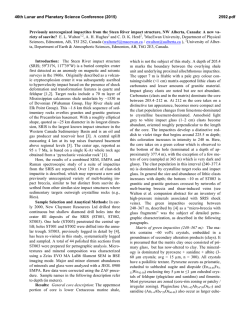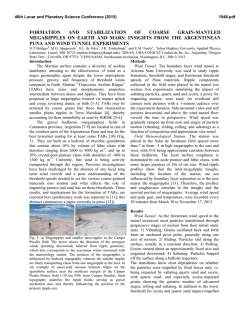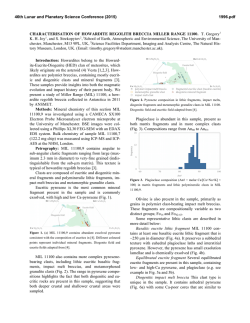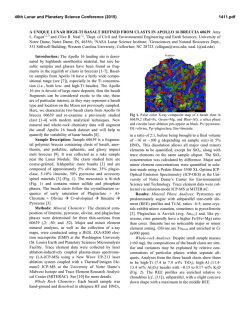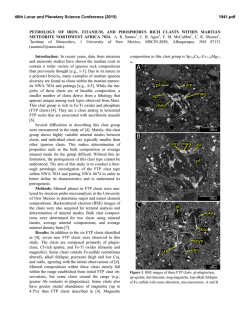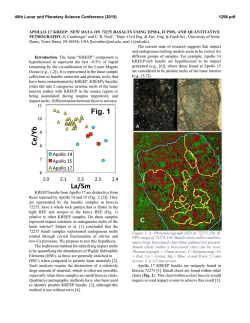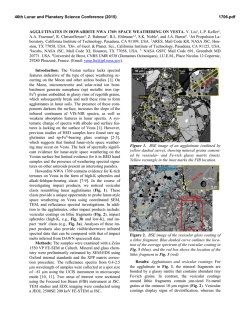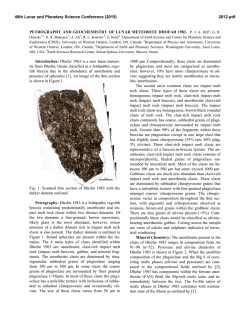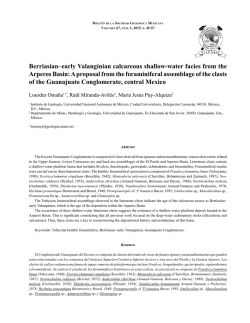
IMPACT HISTORY ON VESTA: PETROGRAPHIC - USRA
46th Lunar and Planetary Science Conference (2015) 1452.pdf IMPACT HISTORY ON VESTA: PETROGRAPHIC, COMPOSITIONAL AND FUTURE CHRONOLOGICAL STUDIES OF MELT CLASTS IN H OWARDITES. J.A. Cartwright1,2, D.W. Mittlefehldt3, K.V. Hodges2, and M. Wadhwa1, 1 Center for Meteorite Studies, 1+2School of Earth & Space Exploration, Arizona State University, Tempe, AZ 85287, 3NASA/Johnson Space Center, Houston, TX 77058. ([email protected]) Introduction: Howardite meteorites are polymict breccias composed mainly of eucritic and diogenitic material [1] that likely originate from the surface of the Asteroid 4 Vesta [2]. They can be separated into two subtypes: Regolithic, which represent the lithified remains of the active vestan regolith; Fragmental, which represent simpler polymict breccias [3]. Amongst the regolithic features observed in the former (e.g., [4-6]), melt clasts are particularly striking for their appearance and compositional variability. They range from glassy spherules to finely crystalline (i.e., devitrified) clasts, and clasts containing only relict mineral grains to those containing only phenocrysts. Glasses can be separated into compositional sub-types including those with low FeO/MgO ratios (<5) -low alkali glasses, K-rich (K2O >0.2 wt.%), Na-rich (Na2O >0.6 wt.%) and CaO-rich, and those with high FeO/MgO ratios (>10) [7, 8]. There is also a distinction to be made between primary volcanic melt clasts and those produced by impacts. While [8] suggested that a lack of chemical homogeneity among their studied melt clasts ruled out a primary volcanic origin, the low siderophile element contents observed in such clasts suggest less compositional influence from impactors than commonly assumed [7]. Studying the chronology of the impact melt clasts in howardites can help us to better determine the timing of impact events on Vesta and the asteroid belt [9]. In this research, we are launching an investigation into the petrology, composition (major/trace element and noble gas) and chronology of melt clasts in howardites. We have selected a set of howardites known to contain large quantities of melt clasts, and have begun the petrological and compositional studies of these materials. Once the melt clasts have been fully classified, we aim to perform chronological studies of individual clasts using both the 40Ar/39Ar and Pb-Pb chronometers, as well as determine the noble gas components present. Of particular note, the study will take advantage of the laser ablation techniques associated with the noble gas facilities at ASU, which will allow high-resolution, in-situ analysis of individual clasts. The broader aim of this work is to ascertain whether the impact flux in the region of the asteroid belt was similar to that on the Moon. Our understanding of impact events in the inner Solar System relies heavily on our analyses of lunar meteorites and returned samples, and there is currently some debate regarding whether there was a “Lunar Cataclysm” event around ~3.9 Ga, or the end of an epoch of “Late Heavy Bombardment” (LHB) at this time (e.g., [10 and refs. therein]). New and more comprehensive constraints on howardite melt clast ages may help determine whether the asteroid belt experienced such a cataclysm or LHB. Methods: We have selected 11 Antarctic howardites (EET 87518, EET 87532, EET 99400, GRO 95535, GRO 95602, LAP 04838, LEW 87004, MIL 05085, PCA 02014, QUE 94200, QUE 97001), 1 fall (Kapo- Fig.1: Photomicrographs (PPL) of Kapoeta showing the range of melt clasts (MC) present as well as eucritic (Euc) or plagioclase clasts (Plag). A) A variety of MCs including those with relict grains & skeletal grains. B) Large impact MC with glassy matrix and relict grains. C) Spherule (Sph) and MC. 46th Lunar and Planetary Science Conference (2015) Fig.2: QUE 94200 and QUE 97001 A) Pyroxene composition diagram. B) BSE of an MC in QUE 94200 with dendritic olivine micro-phenocrysts. eta) and 2 Saharan finds (NWA 1929, Dhofar 485) for this study, as these samples are known to contain high abundances of melt clast material (e.g., [4, 8, 11]). In addition, a number of these samples have been previously analysed for either 40Ar/39Ar or Pb-Pb chronology [9, 12], noble gases on bulk aliquots [5-6] and/or major and trace element compositions [4]. Here we describe our preliminary petrographic and compositional analyses of Kapoeta, QUE 94200, QUE 97001 and EET 87532. Back scattered electron (BSE) images and pyroxene compositions have been determined using the electron microprobe at NASA/JSC. Kapoeta: A range of impact melt clasts, most <2mm in size, have been identified in Kapoeta (Fig. 1). These clasts display glassy matrices, embayed clast boundaries, and often contain relict, partially resorbed grains (e.g., Fig. 1B). These textures were formed by hot melted material mixing with the grains within the regolith following an impact event. Some of the melt clasts show dendritic/skeletal crystals of olivine or low-Ca pyroxene and are free of relict grains (Fig. 1A). If these are of impact origin, the textures suggest almost complete re-melting of material. However, these clasts could also be of volcanic origin. A few spherules were observed (Fig. 1C), which may be volcanic in origin. QUE 94200 and QUE 97001: These two howardites are considered to be paired because of similarities in petrology and bulk composition [4]. A number of melt clasts were observed in them, including a large spher- 1452.pdf Fig.3: EET 87532 A) Pyroxene composition diagram. B) BSE of an impact MC with relict grains. ule fragment in QUE 94200 (Fig. 2B) that displays dendritic olivine micro-phenocrysts. These crystals have a composition of Fo~55, similar to those of coarser olivine grains in the matrix (Fo56-60). Some of the melt clasts contain relict grains and are clearly of impact origin. However, many of the clasts are free of relict grains, but do have micro-phenocrysts of olivine or low-Ca pyroxene, and may be of volcanic origin. EET 87532: Impact melt clasts are present in abundance within EET 87532. Relict grains within these clasts have compositions within the range observed for individual coarse pyroxene grains and matrix grains (Fig. 3A). This howardite also contains abundant ferroan pyroxene fragments that indicate a source of mafic rocks more evolved than the most Fe-rich basaltic eucrites. References: [1] Mittlefehldt, D.W. et al. (1998) Rev. Min. 36: 4.1-4.195. [2] Drake M.J. (2001) MAPS 36:501- 513. [3] Warren P.H. et al. (2009) GCA 73:5918-5943. [4] Mittlefehldt, D.W. et al. (2013) MAPS 48:2105-2134. [5] Cartwright, J.A. et al. (2013) GCA 105:395-421. [6] Cartwright, J.A. et al. (2014) GCA 140:488-508. [7] Barrat, J.A. et al. (2012) LPSC XLIII (abs. #1438). [8] Singerling, S.A. et al. (2013) MAPS 48:715-729. [9] Cohen, B.A. (2013) MAPS 48:771-785. [10] Norman, M.D. & Nemchin, A.A., (2014) EPSL 388:387-398. [11] Barrat, J.A. et al. (2009) MAPS 44:359-374. [12] Bogard, D.D. & Garrison, D.H. (2003) MAPS 38:669-710.
© Copyright 2025
